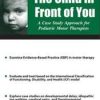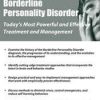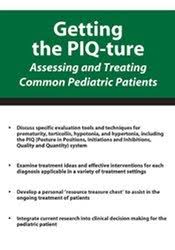Getting the PIQ-ture Assessing and Treating Common Pediatric Patients – Michelle Fryt Linehan | Available Now !
$199.00 Original price was: $199.00.$56.00Current price is: $56.00.
Getting the PIQ-ture Assessing and Treating Common Pediatric Patients – Michelle Fryt Linehan | Instant Download !
Evaluation and Treatment Plans for Common Pediatric Musculoskeletal and Movement Problems
With the rising incidence of cerebral palsy, survival of the tiniest premature infants, and the increased incidence of torticollis, any professionals working with children in an inpatient, outpatient, school, or home environment will undoubtedly be asked to assess and treat children with movement and neuromuscular disorders. A diagnosis of “cerebral palsy” or “developmental delay” is very general and professionals who are asked to treat a child with one of these or other general diagnoses must have a good understanding of the evaluation tools and treatment options that will guide the provision of an individualized, safe, and effective program for each child.
This recording will help attendees choose the best assessment tool (standardized and non-standardized) for each patient and get a comprehensive picture of the patient by using an orderly approach for general observations (PIQ-ture). Goal-setting and treatment ideas will be discussed for each type of patient, noting differences between “evidence-based” treatment ideas and standard protocols used. Leave with many hands-on ideas that can be used immediately in the practice setting, as well as numerous resources and ideas for further study.
- Describe the assessment tools available for pediatric motor evaluations
- Identify assessment tools that are appropriate for use with specific pediatric patients
- Organize information gathered during an evaluation session into a comprehensive report
- Define and describe four common types of pediatric patients seen by motor therapists and school personnel
- Develop a treatment for each of the four types of pediatric patients: children with low tone, high tone, torticollis, and premature infants
- Implement the PIQ-ture assessment tool to complement and complete an evaluation of any pediatric patient
ASSESSMENT OF CHILDREN
- Issues with evaluation of children
- Lois Bly’s Motor Skills Acquisition Check List
- What to evaluate
- Choosing an evaluation tool
- Commonly used norm-referenced tools for general motor skill assessment
- Bayley Scales of Infant Development
- Peabody Developmental Motor Scales
- Movement ABC
- Bruininks-Oseretsky Test of Motor Performance
- Re-evaluation with standardized assessments
- Commonly used criterion-reference pediatric assessment tools
- gross motor function measure (88 and 66)
- school function assessment
- goal attainment scale
- Gathering other pertinent information
- five senses
- the use of PIQ (Posture in Positions, Initiations and Inhibitions, Quality and Quantity)
- Evaluation components
- strength chart
- gait analysis
- Treatment planning
- use of left vs. right brain thinking
- PT/OT diagnoses vs. medical diagnoses
TORTICOLLIS
- Definition and incidence
- Causes
- Changes in developmental milestones with Back to Sleep
- Evaluation
- PIQ
- cranial measurements
- range of motion
- motor evaluation
- Intervention Ideas
- positioning
- range of motion
- case study
PREMATURITY
- Definition, incidence, morbidity, causes
- Long term sequella
- Dynamic systems theory
- Evaluation – subjective and objective information
- complications, feeding, physical aspects
- PIQ
- standardized assessments
- Intervention
- parental education
- supine vs. prone
- frequency, location
- case study
HYPOTONIA
- Definition and clinical characteristics
- Causes
- non-neurological
- central
- peripheral
- Weakness vs. joint laxity vs. low tone
- Assessing children with low tone
- INFANIB
- movement assessment of infants
- gross motor function measure
- PIQ
- range of motion
- sensation and perception – proprioception
- Intervention strategies—moving from diagnosis to treatment
- task analysis + noted impairments → treatment
- chart with treatment ideas
- Patricia Winder’s book
- case study
HYPERTONIA
- Definition and incidence
- spasticity vs. hypertonia
- classification system for cerebral palsy
- Assessing children with tone disorders
- past medical history
- orthopedic issues
- standardized assessments
- PIQ
- causes of in-toeing
- Ryder’s test
- strength, balance, sensation/perception
- Treatment ideas
- strengthening for children with hypertonia
- whole body vibration plate
- NDT
- constraint-induced movement therapy
- taping, stretching, NMES vs. TES
- Adaptive equipment
- PBWB
- standers
- orthotics
- Case study using chart for single goal
Tag: Getting the PIQ-ture Assessing and Treating Common Pediatric Patients – Michelle Fryt Linehan Review. Getting the PIQ-ture Assessing and Treating Common Pediatric Patients – Michelle Fryt Linehan download. Getting the PIQ-ture Assessing and Treating Common Pediatric Patients – Michelle Fryt Linehan discount.
1 review for Getting the PIQ-ture Assessing and Treating Common Pediatric Patients – Michelle Fryt Linehan | Available Now !
Add a review Cancel reply
Related products
Ecommerce
NLP & Hypnosis
Ecommerce
Ecommerce
NLP & Hypnosis
Ecommerce
NLP & Hypnosis












Brendon Ferrell –
Thanks!!! Fast!!! | Getting the PIQ-ture Assessing and Treating Common Pediatric Patients – Michelle Fryt Linehan